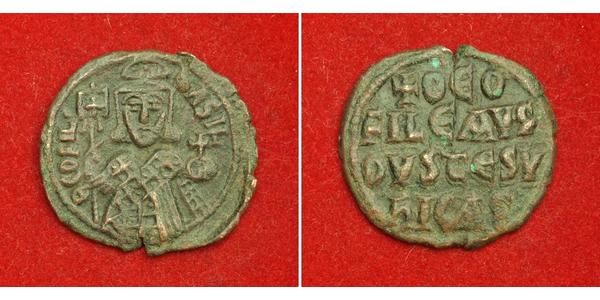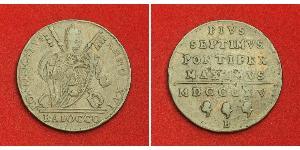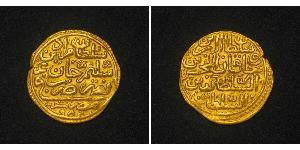(sold for $23.0)
Byzantine Empire, Theophilus (829-842 AD) Bronze Follis Coin. VF-
Denomination: Follis
Mint Place: Uncertain
Condition: Cleaned VF.
References: Sear 1685.
Mint Period: 829-842 AD
Material: Bronze
Diameter: 28mm
Weight: 6.18gm
Obverse: Facing ¾ length bust, holding labarum and globus cruciger.
Reverse: Inscription in four lines.
Legend: +QEO / FILE AVG / OVSTE SV / NICAS.
Theophilos (Greek: Θεόφιλος; sometimes Latinized or Anglicized as Theophilus; 813 – 20 January 842 AD) was the Byzantine Emperor from 829 until his death in 842. He was the second emperor of the Amorian dynasty and the last emperor to support iconoclasm. Theophilos personally led the armies in his lifelong war against the Arabs, beginning in 831.
Theophilos was the son of the Byzantine Emperor Michael II and his wife Thekla, and the godson of Emperor Leo V the Armenian. Michael II crowned Theophilos co-emperor in 822, shortly after his own accession. Unlike his father, Theophilos received an extensive education from John Hylilas, the grammarian, and was a great admirer of music and art. On 2 October 829, Theophilos succeeded his father as sole emperor.
Theophilos continued in his predecessors' iconoclasm, though without his father's more conciliatory tone, issuing an edict in 832 forbidding the veneration of icons. He also saw himself as the champion of justice, which he served most ostentatiously by executing his father's co-conspirators against Leo V immediately after his accession. His reputation as a judge endured, and in the literary composition Timarion Theophilos is featured as one of the judges in the Netherworld.
At the time of his accession, Theophilos was obliged to wage wars against the Arabs on two fronts. Sicily was once again invaded by the Arabs, who took Palermo after a year-long siege in 831, established the Emirate of Sicily, and gradually continued to expand across the island. The invasion of Anatolia by the Abbasid Caliph Al-Ma'mun in 830 was led by the Emperor himself, but the Byzantines were defeated and lost several fortresses. In 831 Theophilos retaliated by leading a large army into Cilicia and capturing Tarsus. The Emperor returned to Constantinople in triumph, but in the autumn he was defeated in Cappadocia. Another defeat in the same province in 833 forced Theophilos to sue for peace (Theophilos offered 100,000 gold dinars and the return of 7,000 prisoners), which he obtained the next year, after the death of Al-Ma'mun.
During the respite from the war against the Abbasids, Theophilos arranged for the abduction of the Byzantine captives settled north of the Danube by Krum of Bulgaria. The rescue operation was carried out with success in c. 836, and the peace between Bulgaria and the Byzantine Empire was quickly restored. However, it proved impossible to maintain peace in the East. Theophilos had given asylum to a number of refugees from the east in 834, including Nasr, a Persian. He baptized Theophobos, who married the Emperor's aunt Irene and became one of his generals. As relations with the Abbasids deteriorated, Theophilos prepared for a new war.
In 837 Theophilos led a vast army of 70,000 men towards Mesopotamia and captured Melitene and Arsamosata. The Emperor also took and destroyed Zapetra (Zibatra, Sozopetra), which some sources claim as the birthplace of Caliph al-Mu'tasim.[6] Theophilos returned to Constantinople in triumph. Eager for revenge, Al-Mu'tasim assembled a vast army and launched a two-pronged invasion of Anatolia in 838. Theophilos decided to strike one division of the caliph's army before they could combine. On 21 July 838 at the Battle of Anzen in Dazimon, Theophilos personally led a Byzantine army of 25,000 to 40,000 men against the troops commanded by al-Afshin. Afshin withstood the Byzantine attack, counter-attacked, and won the battle. The Byzantine survivors fell back in disorder and did not interfere in the caliph's continuing campaign.
Al-Mu'tasim took Ancyra, and al-Afshin joined him there. The full Abbasid army advanced against Amorium, the cradle of the dynasty. Initially there was determined resistance. Then a Muslim captive escaped and informed the caliph where there was a section of the wall that had only a front facade. Al-Mu'tasim concentrated his bombardment on this section, and the wall was breached. Having heroically held for fifty-five days, the city now fell to al-Mu'tasim on 12 or 15 August 838.
In 838, in order to impress the Caliph of Baghdad, Theophilus had John the Grammarian distribute 36,000 nomismata to the citizens of Baghdad. Around 841, the Republic of Venice sent a fleet of 60 galleys (each carrying 200 men) to assist the Byzantines in driving the Arabs from Crotone, but it failed.
During this campaign Al-Mu'tasim discovered that some of his top generals were plotting against him. Many of these leading commanders were arrested and some executed before he arrived home. Al-Afshin seems not to have been involved in this, but he was detected in other intrigues and died in prison in the spring of 841. Caliph al-Mu'tasim fell sick in October 841 and died on 5 January 842.
In 836, following the expiration of the 20-year peace treaty between the Empire and Bulgaria, Theophilos ravaged the Bulgarian frontier. The Bulgarians retaliated, and under the leadership of Isbul they reached Adrianople. At this time, if not earlier, the Bulgarians annexed Philippopolis (Plovdiv) and its environs. Khan Malamir died in 836.
The peace between the Serbs, Byzantine foederati, and the Bulgars lasted until 839. Vlastimir of Serbia united several tribes, and Theophilos granted the Serbs independence; Vlastimir acknowledged nominal overlordship of the Emperor. The annexation of western Macedonia by the Bulgars changed the political situation. Malamir or his successor may have seen a threat in the Serb consolidation and opted to subjugate them in the midst of the conquest of Slav lands. Another cause might have been that the Byzantines wanted to divert attention so that they could cope with the Slavic uprising in the Peloponnese, meaning they sent the Serbs to instigate the war. It is thought that the rapid extension of Bulgars over Slavs prompted the Serbs to unite into a state.
Khan Presian I (r. 836–852) invaded Serbian territory in 839 (see Bulgarian–Serbian Wars). The invasion led to a three-year war, in which Vlastimir was victorious; Presian was heavily defeated, made no territorial gains, and lost many of his men. The Serbs had a tactical advantage in the hills, and the Bulgars were driven out by the army of Vlastimir. The war ended with the death of Theophilos, which released Vlastimir from his obligations to the Byzantine Empire.
The health of Theophilos gradually failed, and he died on 20 January 842. Theophilos strengthened the Walls of Constantinople and built a hospital, which continued to exist until the twilight of the Byzantine Empire.
Only 1$ shipping for each additional coin purchased!

|
Posted by:
anonymous 2016-10-21 |
2 Abazi / 40 Kopeck Russian Empire (1720-1917) Silver
group has 19 coins / 19 prices
⇑















-300-150-amoKbzbi5FEAAAFLoHxKKMQX.jpg)







